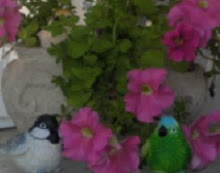Butterflies are abundant in the summer and early fall, so this is the time to

provide a feeder. Making butterfly food is easy – you either mix up a simple nectar or use rotting fruit. To attract the most butterflies, it is a good idea to put out both types of feeders, as some butterflies prefer nectar while others lik

e fruit. The following is how you can make the nectar, just like the
humming birds like too.
Butterfly Nectar
To make butterfly nectar, mix 4 parts water with 1 part organic cane sugar and boil for a few minutes until the sugar dissolves. Cool the nectar thoroughly before adding it to the feeder. Large batches can be made and stored in the fridge for 3-4 weeks. This nectar recipe can also be used for
hummingbird feeders.
Nectar Sponge Feeders for Butterflies
To make a nectar sponge feeder, decorate a glass jar by gluing brightly colored silk or plastic artificial flowers to it or painting bright colors on the outside of it. Waterproof electrical tape in a color that butterflies like (such as red) can be used to attach artificial flowers. This tape is available in most hardware stores.
Next, punch a small hole in the jar lid by placing it on a piece of wood and hammering a large nail through its center. Remove the lid, fill the jar with butterfly nectar, and stuff a piece of cotton or a clean sponge into the hole on the inside of the lid. The sponge or cotton should be a tight fit – trim as necessary.
Screw the lid back on tightly, and use wire or twine to hang it upside down (so that the hole faces the ground) in an open, sunny area, ideally near colorful flowers. Butterflies will suck the nectar through the cotton or sponge.
Clean the butterfly feeder regularly (at least once a week and preferably every three days) using very hot water and a light mild detergent solution to prevent mold from forming. Rinse very thoroughly with pure water before refilling with nectar.
Plate Feeders for
Butterflies
Plate f

eeders can be purchased or made at home using a thin plastic plate or the lid from a large ice cream tub or Tupperware container through which you can punch holes to hang it with wire or twine. Alternatively, you can use a ceramic or metal plate and hang it using a macrame-style hanger.
A plate feeder is a great way to make use of fruit that has gone off. Add slices of fruit that is overripe or spoiling. Butterflies are particularly fond of oranges, grapefruits, strawberries, peaches, nectarines apples and bananas, especially bananas that have be

en stored in the freezer and then thawed so that they become black and mushy.
Once you have added the fruit, hang the feeder and wait for visiting
butterflies to discover it. You can increase the likelihood that butterflies will find your feeder by attaching large, brightly colored plastic or silk
flowers to its edges or to the string or wire that you use to hang it, and by hanging it near large, aromatic real
flowers.
Clean the feeder regularly, and replace fruit when it dries out or becomes moldy. You can keep it moist for longer by adding fruit juice. Butterfly feeders may attract other types of
bugs, so you may not want to hang them right next to your windows or doors.
What do you think? It sounds easy enough to me. That settles it.
LETS DO IT! 
 lready have many plants and flowers that the butterflies like so I’ll add a butterfly house , feeder, and some butterfly stakes or this butterfly and maybe some stepping stones and other things to complete the look. I know I carry a wind chime that I could put on a Shepard’s hook too.
lready have many plants and flowers that the butterflies like so I’ll add a butterfly house , feeder, and some butterfly stakes or this butterfly and maybe some stepping stones and other things to complete the look. I know I carry a wind chime that I could put on a Shepard’s hook too. d decide where to put it. I carry many Gnomes in my storeso that won’t be a problem. I’ll need to decide on a gnome door and windows. Maybe an outhouse and a few mushrooms. I will make a drawing and get started on that too. It will be fun to plan out and I’ll get everything I need on the internet. There are many cute Gnome items to choose from. By the time spring gets here I’ll be ready to get busy. I’ll have to buy a few new birdhouses and hummingbird feeders too. I have anew hummingbird feeder that is a lady bug , it is adorable. See I’m already getting excited about getting out in the garden to work. And it seems like spring is a lifetime away. Well maybe We better have Christmas first. The birdlady
d decide where to put it. I carry many Gnomes in my storeso that won’t be a problem. I’ll need to decide on a gnome door and windows. Maybe an outhouse and a few mushrooms. I will make a drawing and get started on that too. It will be fun to plan out and I’ll get everything I need on the internet. There are many cute Gnome items to choose from. By the time spring gets here I’ll be ready to get busy. I’ll have to buy a few new birdhouses and hummingbird feeders too. I have anew hummingbird feeder that is a lady bug , it is adorable. See I’m already getting excited about getting out in the garden to work. And it seems like spring is a lifetime away. Well maybe We better have Christmas first. The birdlady




